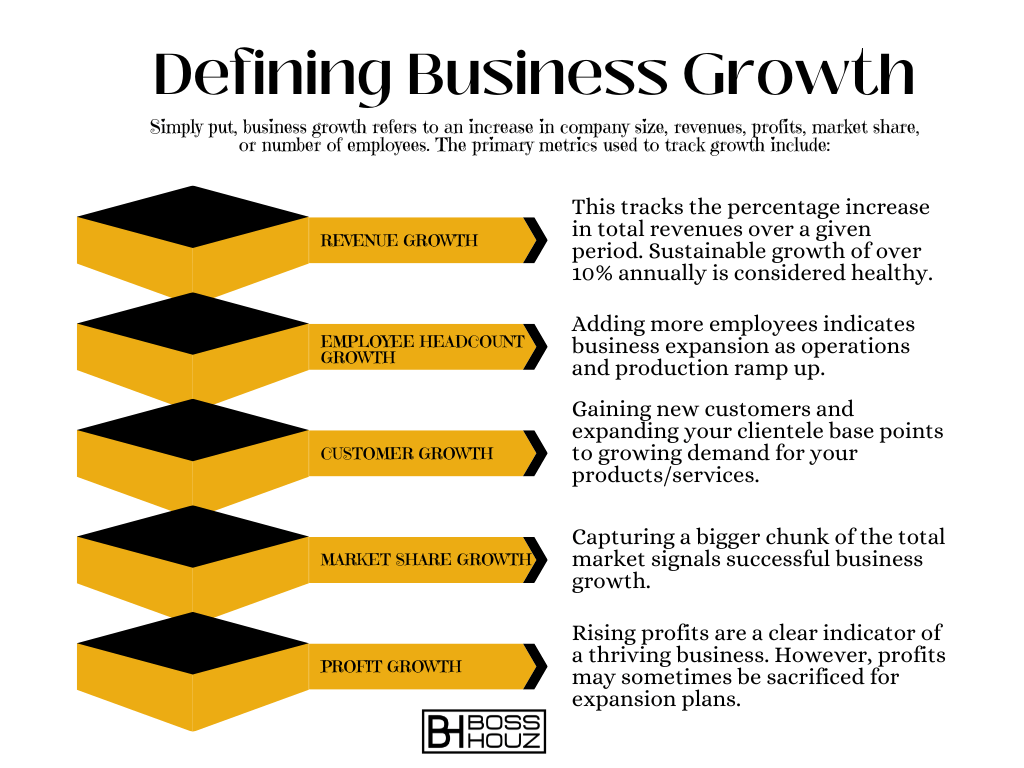Business growth is an enticing prospect for any entrepreneur. The chance to reach new customers, increase revenues, and expand operations is an alluring one. However, growth comes with its fair share of challenges that require careful planning and strategic management.
This comprehensive guide will explore the multifaceted nature of business growth, unpack key strategies for sustainable expansion, and provide actionable tips to help you effectively steer your company through the complexities of scaling up. Whether you are just starting out or leading an established venture, the insights here will prepare you to tackle the obstacles and capitalize on the opportunities that come with boosting your business.
Let’s begin this journey into the intricacies of managing growth with a fundamental question – what exactly constitutes business growth?
Table of Contents
Defining Business Growth


Simply put, business growth refers to an increase in company size, revenues, profits, market share, or number of employees. The primary metrics used to track growth include:
- Revenue growth: This tracks the percentage increase in total revenues over a given period. Sustainable growth of over 10% annually is considered healthy.
- Employee headcount growth: Adding more employees indicates business expansion as operations and production ramp up.
- Customer growth: Gaining new customers and expanding your clientele base points to growing demand for your products/services.
- Market share growth: Capturing a bigger chunk of the total market signals successful business growth.
- Profit growth: Rising profits are a clear indicator of a thriving business. However, profits may sometimes be sacrificed for expansion plans.
While rapid, high growth spells success for any company, it also brings formidable challenges like over-hiring, cash flow issues, quality control problems, or organizational friction. A nuanced understanding of the growth process is therefore critical for sustainable expansion.
The 5 Stages of Small Business Growth
In their seminal work “The Five Stages of Small Business Growth”, Churchill and Lewis framed the growth cycle into distinct stages that businesses typically go through. Being aware of these stages helps managers anticipate organizational needs and chart appropriate strategies. The 5 identifiable stages are:
Stage 1: Existence
In the Existence phase, entrepreneurs struggle for survival as they work on validating their business idea. Sales are low, bank balances are tight, and the focus is on building a viable product and acquiring first customers. Owners are in firefighting mode trying to stay afloat.
Stage 2: Survival
The Survival stage sees the business stabilizing as it identifies a core customer base. Revenues witness stability and initial processes get ironed out. However, growth is still organic and reactive. Owners become more experienced but cash and resources remain scarce.
Stage 3: Success
At this stage, sales take off as processes smooth out and the business model gains validation. Growth becomes proactive as owners seek additional financing to scale. Systems get more defined and decentralized decision-making emerges to meet growing demands.
Stage 4: Take-Off
In the Take-Off phase, businesses encounter a surge in growth and new opportunities open up. Infrastructure and staff struggle to keep up with rising sales. Systems require constant adaptation and owners risk losing control. Cash is ploughful but needs careful management.
Stage 5: Resource Maturity
At Resource Maturity, growth plateaus and focus shifts from rapid expansion to stability. Management is highly structured and growth needs to be reinvigorated through new markets/products. Systems get decentralized and financial resources are freely available. The company is now positioned as an industry leader.
Recognizing these distinct stages helps entrepreneurs calibrate their expectations and strategy as the business evolves. While rapid acceleration to the Take-Off stage might seem tempting, it often pays to first strengthen foundations and processes. With the basics of growth stages clear, let’s now move on to practical strategies for managing the growth spurt.
9 Ways to Avoid Being Crushed by Rapid Business Growth


Rapid business growth is a high-quality problem that most entrepreneurs aspire to have. However, handled poorly, it can completely overwhelm your systems and resources. Here are 9 potential pitfalls to watch out for when experiencing hypergrowth:
- Uncontrolled hiring: Taking on more employees than you need can inflate expenses dangerously. Avoid over-hiring even if you can afford it.
- Loss of quality control: Scaling production rapidly can compromise quality if standards are not maintained. Never sacrifice quality for arbitrary growth targets.
- Disgruntled early customers: Neglecting existing customers while acquiring new ones can frustrate your early adopters. Balance serving both new and existing users.
- Stressed finances: Fast growth strains working capital if expenses scale up quicker than revenues. Monitor cash flow regularly to prevent disruptive shortfalls.
- Gap in leadership: Rapid promotion or inconsistent leadership can perplex employees. Growth still needs seasoned direction to stay constructive.
- Outgrowing infrastructure: Inadequate office space, systems, or equipment can cripple operations. Proactively scale infrastructure to support growth.
- Culture deterioration: Loss of the intimate culture that drove initial success. Maintain cultural ethos even as processes get systemized.
- Increasing bureaucracy: Rigid structures or over-complex processes that earlier facilitated growth can now impede agility. Keep things flexible and streamlined.
- Icarus syndrome: Letting growth and success go to your head can make you reckless and ignore signs of trouble. Retain humility and laser focus even during rapid ascent.
While quick expansion does bring headaches, it is still a goal worth pursuing. Just be sure to celebrate the small wins, invest back into your business, and over-communicate with your team when encountering rapid acceleration. Maintaining growth momentum over the long-term requires mastering the balancing act between scaling fast and staying rooted.
6 Tips for Managing Rapid Business Growth
Rapid growth can seem like an exciting rollercoaster ride that leaves you breathless. However, to prevent the wheels from coming off, it requires judicious steering and measured maneuvers. Here are 6 tips to help effectively manage phases of hypergrowth:
1. Prioritize resources wisely: When everything feels pressing, you end up getting nothing done. Identify key priorities and focus efforts there first. Say no to non-essential work.
2. Develop scalable systems: Automate processes using technology so that operations can expand without excessive human intervention. Document procedures so that new hires can quickly come up to speed.
3. Monitor metrics diligently: Keep close tabs on leading indicators like customer churn, quality defects, support backlogs that can offer early warning signs of trouble ahead. Address even small anomalies promptly.
4. Communicate proactively: Provide frequent and transparent communication to employees and customers. Rumors and uncertainty are growth killers. Share challenges openly and regularly.
5. Plan in sprints: Do long-term planning but execute in controlled phases so you can track progress and adapt quickly. Think of growth as a guided evolution, not a wild explosion.
6. Stick to your core: While exploring new directions, stay anchored to your core mission, values and identity. Deviation from your core DNA can lead to dangerous fragmentation.
While rapids might seem scary at first, just remember to row in the direction of the current, make minor course corrections, and keep your eyes peeled for big rocks! With some white-knuckled moments, you will steer through the torrent – just be sure to come out of it with your raft and sanity intact!
Unlocking Business Growth: Key Strategies for Expansion
All businesses aim to grow, but merely desiring growth is insufficient to achieve it. You need deliberate strategies and execution machinery designed for expansion. Here are some proven business growth strategies to consider:
Expand to new markets: Tap into new demographics, geographies, or distribution channels. Options include new product lines, partnerships, mergers, and acquisitions.
Increase market share: Gain share from competitors by understanding and serving customers better. Improving product quality and service levels pays off.
New sales channels: Move beyond physical stores to online catalogs, websites, mobile apps. Diversify across channels to access wider audiences.
More sales personnel: Invest in expanding your sales team and providing proper sales training. However, ensure you have a scalable sales process first.
Upsell existing customers: Sell premium offerings, warranties, accessories, and services to current customers. Identify needs you can fulfill.
Customer evangelism: Turn happy customers into brand ambassadors. Loyal customers who bring new leads are invaluable. Reward referrals and user-generated content.
Improve conversion rates: Small optimizations in conversion rate compound long term revenue growth. Test pricing, placements, and messaging through A/B experiments.
Partnerships and tie-ups: Complementary brand associations and joint marketing allow mutually beneficial growth. Partners provide new channels while reducing customer acquisition costs.
Rather than betting on a single grand strategy, pursue multiple growth levers in parallel. Comprehensive techniques focused on new markets, better sales, and increased referrals will unleash growth. Just avoid complacency and keep expanding your growth playbook.
7 Key Steps for Formulating a Business Growth Strategy
Growth doesn’t happen by accident – it needs a carefully chartered flight plan. Follow these 7 steps to formulate a focused growth strategy:
1. Assess current state: Analyze your current marketing metrics, sales data, customer feedback and competitive position. Know where you are right now.
2. Confirm priorities: Based on internal needs and market reality, decide which business priorities like revenues, profits or market share need the most attention.
3. Define objectives: Set specific, measurable goals for the various metrics you want to impact – foot traffic, lead generation, conversion rate etc.
4. Identify growth drivers: Determine key drivers that will have the greatest impact on your chosen goals – pricing, market reach, promotions etc.
5. Create execution plan: Outline the specific strategies, resources and timelines required to boost each growth driver and achieve your quantified objectives.
6. Monitor progress: Establish clear milestones and metrics to track. Capture baseline measurements before launching strategies.
7. Refine and update: Review progress periodically against milestones. Fine-tune strategies and reallocate resources accordingly. Revisit underlying assumptions.
Formulating a growth strategy requires a deep understanding of your business’ DNA, past performance and untapped potential. With clear priorities, pragmatism and an adaptive approach, your strategies will gain the focus and alignment needed to deliver results.
Why You Should Document Your Growth Strategy
In the excitement of expansion, business leaders often sidestep formally documenting their growth plans. However, taking time to create a written strategy brings immense benefits:
- Creates alignment – A documented plan aligns various leaders to shared goals and accountability. This prevents disjointed efforts.
- Enables analysis – A written plan allows deeper analysis to refine strategies. Assumptions can be stress tested.
- Improves communication – A document makes it easier to communicate plans across the organization. Employees understand their contribution better.
- Allows tracking – Documenting baseline metrics and milestones enables tracking of progress. Impact of initiatives can be measured.
- Institutionalizes knowledge – A document captures institutional knowledge and reduces dependence on a few people. Learning remains even as people transition.
- Boosts preparedness – A written plan prepares the organization for rapid growth. Infrastructure and hiring needs can be anticipated.
- Enforces discipline – A documented strategy imposes discipline in goal setting, allocation of resources and project management.
While detailed long term planning isn’t realistic, putting in dedicated time to create a strategy overview is time well invested. Even a few pages that capture goals, metrics and broad execution plans can go a long way in steering growth positively.
Balancing Speed and Control During Business Growth
Rapid business growth is a high-class problem that most entrepreneurs covet. However, scaling too fast can also be catastrophic if you outpace your team’s capacity to deliver. Speed and control require delicate balancing during growth phases. Here are some tips to manage this tension:
- Set realistic growth targets that extend your capabilities slightly rather than overwhelm them. Build growth momentum in increments.
- Add capacities like staff, systems and space proactively to stay ahead of demand. However, keep buffers low to maintain leanness.
- Keep processes agile to handle volume spikes but introduce structure for repeatability as you scale. Maintain flexibility.
- Centralize strategic decision-making but decentralize customer interactions for responsiveness. Empower frontline employees with autonomy.
- Use metrics like customer satisfaction, service levels and product quality to monitor if growth is compromising user experience.
- Automate wherever possible so that humans handle exceptions and strategy. Leverage technology to maintain control at speed.
- Communicate the context of short-term tradeoffs to sacrifice control. Ensure employees don’t see uncontrolled growth as the new norm.
- Instill a customer-centric culture focused on problem solving not just growth. The right values anchor quality even during rapid expansion.
With strategic prioritization, delegation of authority and operational buffers, businesses can crisply scale up without flying blind. Growth and control are mutually enabling, provided you take the right preemptive actions.
Hiring for Growth: Getting the Right People on the Bus
The right hires separate winning companies from those left behind. But with growth, hiring needs and priorities change substantially. Here’s how to effectively recruit for your growth journey:
- Anticipate hiring needs: Forecast additional capabilities and talent you need to fuel projected growth. Build a hiring plan to stay ahead of needs.
- Focus on learners: Look for innate curiosity and learning agility over specific domain expertise. Skills can be learnt but not attitude.
- Emphasize cultural fit: Beyond skills, assess alignment with company values. Culture sustains growth by keeping people united.
- Think scalable skills: Hire for broad, transferable skills over specialized niche skills. Generalists morph as needs change.
- Diversify backgrounds: Bring in people with different perspectives and work experiences. Diversity of thought sparks innovation.
- Take a long-term view: Evaluate candidates on future leadership potential and ability to grow, not just immediate role fit.
- Sell the vision: Candidates need to buy into your vision and growth story. Ensure recruiting conveys your expansive future roadmap.
- Compensate appropriately: Structure compensation attractively for a high-growth company. Offer sufficient upside potential to talent.
With the right hiring blueprint, you can rapidly compose a dream team that sustains, rather than impedes, your steep growth trajectory.
Should You Use CRM Software to Manage Growth?
Here are some pros and cons of implementing a CRM system to stay atop of customer relationships during business growth:
Pros:
- Centralized data: CRMs consolidate customer data from all channels into one place for easy access and analysis. Prevents data silos.
- Automation: Auto-triggers for workflows like email nurturing, contract renewals and appointment setting save significant manual work.
- Lead management: Track lead status seamlessly across sales, marketing and support for optimized conversions.
- Accessibility: Sales reps have customer context at their fingertips anytime, anywhere to engage better. Management has visibility into pipelines.
- Customization: CRMs are highly customizable to model business’ unique processes, terminology and metrics.
- Analytics: CRMs generate reports and insights from customer data – sales forecasts, marketing ROI, churn risk indicators etc.
- Scalability: Cloud-based CRM systems scale seamlessly with business growth. Pricing is based on usage.
Cons:
- Costs: Subscription and implementation costs for CRMs make them prohibitive for very early-stage startups.
- Training: Sales reps need training to properly utilize CRM features and maintain data hygiene. This requires effort.
- Maintenance: Keeping data updated across the customer lifecycle needs discipline. Garbage in, garbage out.
- Fragmentation: Syncing data across other tools like marketing, payments and support systems can be challenging.
- Customization: Excessive customization for niche use cases can make upgrading tricky and reduce out-of-the-box benefits.
Overall, the benefits outweigh the costs in most cases. CRMs become invaluable as companies scale, provided you choose the right system and invest in user adoption. When managed well, they are a prudent growth enabler.
Customer Communication During Business Growth
Here are some tips for managing customer communication as your business grows rapidly:
- Automate where possible – Leverage email, in-app messages, SMS and chatbots to handle routine communication at scale. But ensure personalization.
- Empower frontline staff – Trust employees to directly engage customers and resolve issues. However, arm them with brand messaging.
- Centralize data – Aggregate data from all channels into a CRM system for faster servicing and avoiding repetitive inquiries.
- Monitor ratings – Keep a close eye on satisfaction scores, online reviews and feedback surveys. Address complaints promptly.
- Segment strategically – Group customers by value, preferences and needs. Customize engagement for each segment.
- Stay transparent – Share updates proactively on order issues, product changes, or service disruptions. Over-communicate.
- Institute escalation protocols – Make it easy for customers to escalate to supervisors in case of delayed responses.
- Gather feedback – Actively collect customer opinions through surveys, interviews and review sites. Incorporate learnings.
- Highlight growth – Convey stories of your expansion, new capabilities and future plans. But avoid sounding impersonal.
- Reward loyalty – Surprise and delight long-term customers with small gestures of appreciation as you grow.
Open, honest and frequent communication ensures customers continue feeling valued, not overlooked, amid your growth. Small touches also help reinforce bonds even as you scale rapidly.
Training Employees to Adjust to Business Growth
Company growth brings change that existing employees must adjust to. Here are some tips for training employees to adapt and thrive during expansion:
- Communicate context – Explain why growth initiatives are being pursued and how they align with vision. This brings buy-in.
- Train on new skills – Instruction on new technologies, processes and responsibilities makes staff confident handling their evolving role.
- Listen to concerns – Provide forums for employees to voice worries and objections. Discuss how they will be addressed.
- Illustrate benefits – Highlight how growth will lead to enriching opportunities, job progression and profit-sharing for employees. Rally them around the vision.
- Assign mentors – Pair staffers unfamiliar with new responsibilities with knowledgeable mentors who can share practical insights.
- Track progress – Check training effectiveness through tests, observation and regular feedback surveys. Refresh skills where needed.
- Incentivize learning – Consider tying bonuses or wage increases to new skills acquired. This motivates continuous learning.
- Rotate assignments – Move employees through different roles laterally to build multifunctional visibility and appreciation of challenges.
- Promote internally – Prioritize filling new positions from within the company. This builds loyalty and enables career growth.
- Be flexible – Accommodate staffers overwhelmed by change by providing additional training, job rotation or mental health leave.
With empathy, patience and an opportunity mindset, leaders can get employees energized and equipped for the growth journey ahead.
Are You Ready to Handle Growth Challenges?
Rapid growth can strain organizations in ways leaders fail to anticipate. Here are preparatory steps to tackle the unique challenges hypergrowth brings:
- Stress test capacities – Thoroughly pressure test your operational capacity, systems and processes to breaking point. This reveals weak links.
- Know historical patterns – Analyze challenges typically faced at your current growth stage based on industry data. Forewarned is forearmed.
- Listen to the ground – Learn about specific pain points from frontline employees interacting with customers and technology.
- Assign owners – Designate leaders responsible for preemptively addressing challenges in their domain before they become unwieldy.
- Build organizational slack – Buffer additional staff, equipment and financial reserves to absorb unexpected shocks during growth phases.
- Conduct fire drills – Simulate worst-case scenarios and run fire drills to train employees on crisis response protocols before disaster strikes.
- Stay nimble – Keep processes lean to enable quick adaptations as challenges emerge. Bureaucracy stifles agility.
- Communicate transparently – Share challenges openly across the company to align all stakeholders to resolution, not concealment.
- Review periodically – Keep revisiting your readiness as growth accelerates. Ensure preparations evolve correspondingly.
Remaining ever vigilant, resilient and quick to respond will help you smoothly steer around the icebergs when growth gains speed.


Make Customer Relationships an Everyday Priority
Maintaining exemplary customer service during growth spurts is vital yet challenging. Here are tips to keep customer relationships strong day-to-day:
- Gather feedback proactively through surveys, interviews and monitoring reviews. Listen intently for changes in sentiment.
- Address complaints quickly and compassionately. Empower service staff to go the extra mile.
- Automate carefully so customers still feel valued, not commoditized by technology. Blend digital with a human touch.
- Individualize engagement based on purchase history, communication preferences and sentiment. Personalization, not scale, builds loyalty.
- Train staff extensively on company values, branding, ethics and standards so that culture and service levels remain consistent.
- Make it easy to reach you through multiple channels – chat, email, social media, phone. Meet customers where they are.
- Surprise and delight loyal buyers with small gifts and extra service perks. Go out of your way to make them feel special.
- Share your growth story so customers feel invested in your expansion. Make them want to grow with you.
- Appoint customer advocates to represent their voice in sales meetings and product development.
Staying obsessively customer-focused amid rapid growth requires figuring creative ways to honor relationships even as processes scale. When service suffers, growth claims a heavy casualty.
Exploring Different Avenues for Growth
Companies have several strategic options to pursue growth. Let’s examine the benefits and limitations of each approach:
Organic Growth
Organic growth comes from within the organization through existing channels. This includes:
- Offering new products/services – Expanding your portfolio attracts new customers while serving existing ones better.
- Entering new markets – Targeting new customer segments, demographics and geographies expands your accessible market.
- Improving marketing and sales – Sharpening value messaging and distribution effectiveness boosts conversions.
- Enhancing customer experience – Improving onboarding, support and engagement increases loyalty and referrals.
- Increasing prices – Raising prices, done judiciously, can markedly improve revenues.
- Boosting efficiency – Doing more with less via process improvements enhances productivity and reduces costs.
While slower, organic growth is safer and enables fine-tuning products for market needs. Patience is key.
Strategic Growth Through Mergers and Acquisitions
Inorganic growth is achieved by merging with or acquiring other companies. Benefits include:
- Accelerated expansion – Mergers allow rapid growth in scale, market access and capabilities.
- Access to assets – Acquiring companies opens doors to customers, IP, technology, and talent.
- Increased bargaining power – Improved competitive position leads to better supplier terms, financing and market pricing.
- Enhanced innovation – Exposure to new ideas, processes and technology through acquired entities stimulates innovation.
However, M&A carries integration risks that can undermine expected value. Cultural clashes, regulatory hurdles, inflated price and loss of agility need prudent management.
While instant gratification tempts many leaders, smart acquisitions done for the right reasons can provide a strategic growth catapult difficult through organic means alone.
Growth Through Strategic Partnerships
Partnership with other industry players is a middle path that provides benefits of scale without the risks of M&A:
- Shared expertise and assets – Partners bring complementary capabilities, resources and connections.
- Expanded reach – Leveraging partner channels and customer base expands collective market access.
- Economies of scale – Partners can bundle offerings to provide integrated solutions not possible alone.
- Knowledge exchange – Exchange of data, insights and ideas between partners enables mutual learning and innovation.
- Lower risk – Partnerships allow exploration of new markets and products without full resource commitment. Failed pilots limited.
However, partnerships bring some loss of control over customer experience and business direction. Differences in partner priorities may also emerge over time.
When strategically chosen, partnerships provide invaluable leverage for growth by uniting complementary strengths for mutual benefit.
Internal Process Improvement
Overlooking internal health in the quest for expansion can backfire. Some key process improvements include:
- Enhancing productivity through workload balancing, automation and communication enhancements.
- Improving quality by analyzing defects, honing processes and instituting checks.
- Shortening cycle times via production optimizations, decision delegation and bureaucracy reduction.
- Adding capacities to avoid constraints in people, systems and equipment.
- Building buffers through excess staffing, inventory and work-in-progress to handle variability.
- Smoothing workflows by eliminating cross-functional disconnects and bottlenecks.
- Empowering execution by pushing decision making closer to frontlines.
While not obvious growth levers, fixing internal inefficiencies and delays compounds gains over time from the same resources and assets.
Growth Levers to Pull in the Digital Age
The internet and mobile connectivity provide new avenues for business growth:
Leverage Social Media
- Increase brand awareness through viral content and influencer associations.
- Generate leads and sales by targeted advertising on platforms like Facebook and Instagram.
- Engage customers actively through your own social media presence and community building.
- Obtain quick product validation and feedback by sharing prototypes with online audiences.
- Recruit talent by establishing your company as an attractive workplace online.
Pursue E-Commerce
- Sell to a global consumer base by launching transactional websites and mobile apps.
- Provide buying convenience, personalization and subscription models.
- Employ search, display and affiliate marketing for discovery by new shoppers.
- Utilize data and A/B testing to optimize shopping experience.
Go Cloud
- Boost productivity, collaboration and customer access by adopting cloud-based systems.
- Enable remote working through cloud communication and project management tools.
- Gain usage-based cost flexibility and scalability.
- Reduce hardware costs and IT maintenance overheads for company operations.
The digital revolution opens up possibilities for rapid growth at minimal incremental investment by harnessing the power of online networks and information systems.
Emerging Trends Reshaping Business Growth
Business growth playbooks are being reshaped by disruptive new trends. Here are a few innovations to watch:
- Leveraging big data analytics – Detecting consumer insights and predictive intelligence from data assists strategic decisions and hyper-personalization.
- Artificial intelligence – AI drives business growth through personalized recommendations, predictive demand forecasting and intelligent customer interactions.
- Internet of Things – Connected devices provide real-time product usage insights and environmental data to unlock new revenue streams and operational efficiencies.
- Experiential retail – Immersive in-store experiences using VR/AR technology entice customer visits and social sharing even amid ecommerce dominance.
- Direct-to-consumer models – Selling directly to consumers online pares distribution costs and forges deeper engagement.
- Subscription models – Offering subscriptions for services, products and access provides stable recurring revenues.
- Influencer marketing – Associating with popular personalities and subject experts provides credibility. Their followers represent potential new customers.
- Sustainable and ethical focus – Millennials and Gen Z show higher preference for ethical brands with sustainable sourcing and operations.
Innovative strategies that harness emerging technologies, new business models and cultural shifts will dictate who leads markets of the future. Companies anchoring themselves in the past will find growth hard to ignite.
Key Takeaways on Managing Business Growth
Here are the main ideas from our comprehensive guide on steering business growth effectively:
- Growth needs a strategic blueprint with concrete objectives, initiatives and metrics. Avoid ad hoc expansion.
- Rapid growth brings unique challenges – identify and tackle them proactively before they overwhelm you.
- Balance speed with stability. Move fast but not recklessly. Maintain strong fundamentals even while scaling.
- Focus on sustainable growth driven by customer needs, not arbitrary goals. Shortcuts usually backfire. Stay patient.
- Leverage technology to improve efficiencies, enable innovation and boost data-driven decisions. But keep the human touch.
- Hire, train and communicate with your team proactively. People are your biggest asset during growth journeys.
- Frequently gather customer feedback. Nurture relationships amid expansion. Make staying customer-centric a priority.
- Continuously improve systems and processes. Eliminate internal friction that can hobble growth.
- Stay financially prudent. Manage cash flows, keep costs lean and anticipate new investment needs.
With the right strategic choices and disciplined execution, your business can expand smoothly. Growth fuels further possibilities, provided you scale thoughtfully.
Frequently Asked Questions About Business Growth
Q: How fast should a business ideally grow?
A: There is no single ideal growth rate. Aim for steady, sustainable growth between 10-25% annually. Expanding too slowly misses opportunities but growing too rapidly risks instability. Set growth targets based on industry benchmarks, past performance, team capacity and access to capital.
Q: Which metrics best indicate business growth?
A: Key growth metrics are – revenues, profits, number of customers, products/services sold, market share, geographic reach and team size. However, evaluate growth holistically across financial, operational and customer metrics instead of optimizing for a single metric.
Q: When does a business need external funding to support growth?
A: Funding is likely needed once a business exhausts internal financing and requires additional resources to seize a major growth opportunity. Common scenarios include expanding into new markets, upgrading technology and infrastructure, hiring more talent or acquiring other companies.
Q: What role does technology play in enabling business growth?
A: Technology is a key enabler and differentiator. It assists growth by improving productivity, customer reach, data insights, product experience, marketing effectiveness, automation and innovation. However, focus on solving customer problems first rather than chasing technology fads.
Q: Is rapid growth sustainable over the long term?
A: Very rapid, exponential growth is rarely sustainable indefinitely. However, managed well, hypergrowth for short durations can decisively establish market dominance before shifting to steadier growth. The key is not getting blinded by initial euphoria and retaining focus on foundations.
Q: How can I make customer relationships a priority during business growth?
A: Constantly gather customer feedback, address complaints promptly, reward loyalty, train staff on company values, automate intelligently balancing digital with a human touch, stay transparent about changes and have customers play a visible role in your growth story.
Q: What are leading indicators of growth trouble that I should watch out for?
A: Early warning signs include stagnating conversion rates, rising customer complaints, mediocre product reviews, high employee turnover, missing delivery targets, quality issues and downward trending market share. Address even minor red flags promptly before they balloon into major problems.








